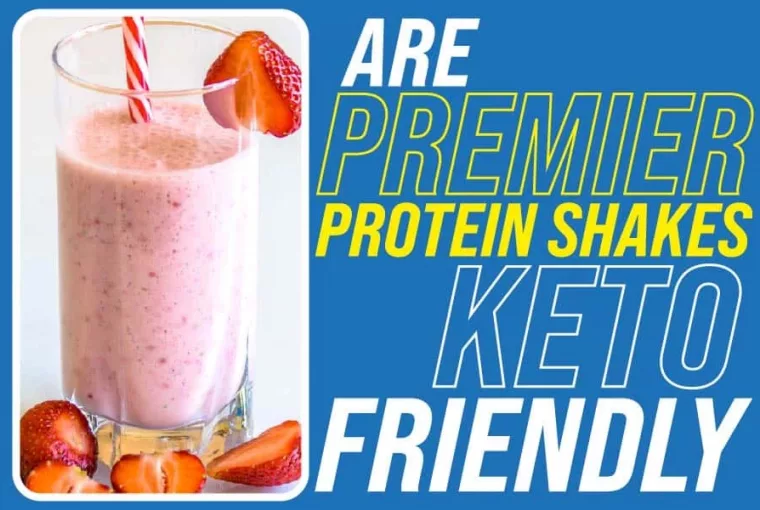A keto diet, also known as a ketogenic diet, is a high-fat, low-carb diet. It is intended to assist in weight loss and has several other health-related advantages. The diet works by inducing a state of ketosis.
Ketosis is the process whereby the liver produces ketones and deposits them in the muscular tissues. Ketones provide the body with basal energy in the absence of carbohydrates. The liver metabolizes proteins into energy for the body to use.
Ketosis is triggered in the absence of carbohydrates. It is a natural stimulus that ensures that you survive under starvation conditions. Inducing ketosis through low carb intake is known as dietary ketosis.
Are you looking to get on a budget-friendly and effective ketogenic diet? Click here for the best deals.
It would be best to regulate your carbohydrate and protein intake for a keto diet. So, Are Premier Protein Shakes Keto Friendly?
Premier protein shakes are indeed keto-friendly. A premium protein pack typically contains a low concentration of carbs in relation to protein. The ratio is 1:6; there are 6 grams of protein for every gram of carbohydrates. The ratio makes it permissible for use if you are on keto.
What Benefits Do I Get From A Ketogenic Diet?
There are quite many benefits accruing to being on a Ketogenic diet. The diet has been used to solve several health-related problems, and more studies are being conducted to perfect it.
The high-fat low carb diet is helpful in the following ways:
1. Slowing Down the Replication of Cancerous Cells in the Body
While more studies are being conducted on the validity of keto for cancer management, early findings are pretty promising.
Research has shown that inducing ketosis can inhibit the replication of cells that cause cancer. The cells are deprived of glucose, which is essential for multiplication and other metabolic processes within such cells.
2. Treating Heart-Related Ailments
Keto diets have been linked to an increase in the production of lipoproteins. These proteins combine to form a specific type of cholesterol that decreases risk factors for cardiovascular ailments. Lipoproteins are only available in certain fats, such as avocado oil, omega 3, and canola oils.
3. Improved Respiratory Health
A keto diet reduces hemorrhagic shock on lung cells. It minimizes the respiratory, metabolic processes as glucose oxidation occurs at fewer intervals and in fewer volumes. It results from a substantial decrease in carbohydrate intake.
4. Urinary Tract Health
It is advisable to adhere to a standard ketogenic diet for good renal health. Studies indicate that you could regulate the body’s response to glucose by reducing your carbohydrate intake. Hydroxybutyric acid makes the body more tolerable to elevated levels of carbohydrates.
What Are The Different Types Of Ketogenic Diets?
While keto diets operate on basically the same principle, the intake of fats is supposed to be high in relation to carbohydrates.
Not all keto diets are the same. The diet is classified into four main categories based on the ratio of fat, proteins, and carbohydrates.
These keto diets are:
1. Standard Ketogenic Diet
It is the standard recommended keto diet. The standard ketogenic diet consists of fat to protein to carbohydrate diet in the ratio of 7:2:1. It is recommended that for every 10 grams of carbohydrate intake, you should consume 20 grams of protein and 70 grams of fat.
Any carbohydrate intake exceeding 25 grams in 25 hours interferes with standard ketogenic diet ketosis.
The diet is intended to stimulate the ketosis process within a short duration.
2. Targeted Ketogenic Diet
The Targeted Keto Diet is a variation of the Standard Ketogenic Diet. All the ratios remain the same while on the TKD. The difference is whereby you can eat carbohydrates 45 minutes before exercising.
Targeted Ketogenic Diet is suitable for people who are doing exercise that triggers the muscles. It increases the glucose levels just enough to get you through the workout without shifting the body out of ketosis for prolonged periods.
3. Cyclical Ketogenic Diet
Cyclical Ketogenic Diet combines the standard diet with days that allow for carbohydrate intake. It is recommended for athletes.
The CKT is intended to trigger glycogenesis, converting carbohydrates into essential monosaccharides. Respiration occurs, and the body uses the energy produced in the process.
4. High Protein Ketogenic Diet
For a high protein keto diet, the ratio of 6:3:1 for fat, protein, and carbohydrates is appropriate. For every 10 grams of carbohydrates you consume, you should eat 30 grams of protein and 60 grams of fat.
Premier protein shakes are perfect for high-protein ketogenic diets.
Common Side-Effects Of Switching To A Ketogenic Diet
Switching to a keto diet may result in some side effects. Most of these effects should be gone after a few weeks. However, they may also persist throughout the diet. The side effects also vary in terms of their severity.
Here are some common side-effects of a keto diet:
1. Fatigue When Doing Light Tasks
You should expect some fatigue when you switch to keto. The body typically metabolizes glucose into energy during respiration. The glucose, in this case, comes from carbs that have been digested into simple monosaccharides.
By minimizing carb intake, the body is deprived of glucose and consequently metabolizes protein into energy. Metabolizing protein into energy is slow and doesn’t reasonably produce as much energy as carbohydrates.
When in ketosis, avoid doing physically demanding tasks, as it could result in undesirable fatigue levels. You can combat fatigue by taking frequent naps during the day.
2. Difficulty With Bowel Movements
Most people who start a keto diet tend to experience mild constipation in the first few weeks. It is a result of the body being deprived of roughages. Most roughages occur naturally in carbohydrate-based food.
It would be best to increase your water intake during the day, as it could help combat constipation.
3. Hypoproteinemia
Hypoproteinemia is a condition characterized by a significant decline in blood protein levels. It stems from protein metabolization, as the body attempts to provide basal energy due to a glucose shortage.
Some common symptoms of low blood protein are decreased skin turgidity and thinning hair.
4. Feeling Nauseous
The feeling of nausea is expected when you first switch to a keto diet. It results from the body adapting to a high-fat diet.
You can mitigate the feeling by using anti-nausea medication. If the feeling persists, you should consult your doctor.
Who Should Consider A Keto Diet?
While a keto diet is appropriate for almost everyone, some subgroups could benefit from the diet more than others. They are:
1. Children Suffering from Epilepsy
A ketogenic diet is recommended for children who have epilepsy. The diet has been known to reduce epileptic seizures in children by half. It has also been known to eliminate attacks in 10% of all child patients.
Note that the diet is not a substitute for epilepsy medication but only complements the treatment.
2. Type 2 Diabetics
Research has shown that a keto diet reduced the severity of type 2 diabetes in 6 out of every ten patients. The patients were on a diet for 12 months, and then, as a result, most of them were able to regulate their insulin without the shots.
3. People With Metabolism Irregularities
A keto diet could help restore a regular metabolic cycle to people who suffer from irregularities. It includes people who suffer from obesity as well as diabetes.
What To Avoid When On A Keto Diet
To maintain ketosis, you should be selective about what you eat. Any excessive consumption of protein or carbs could ruin your diet.
Here is a list of food that you should avoid:
Fruit: Fruit contains fructose, a saccharide that, when metabolized, increases blood sugar.
Beans: While beans have high protein levels, they also contain a high proportion of carbohydrates and should be avoided.
Low-fat products: Avoid all low-fat products, including salads and other sugar-free foods.
Grains: Grains contain a high concentration of carbohydrates and unsaturated oils and should be avoided.
Alcohol: Avoid all alcoholic beverages.
Saturated fats: The fat you eat while on keto should be unsaturated. It is advisable to get fat from several sources such as avocado, chia seeds, coconut oil, and olive oil.
Fruit juice: Do not take fruit juice, whether natural or in its processed form.
Tubers: These include sweet potatoes, arrow roots, yams, sunchokes, jicama, etc.
Conclusion
A ketogenic diet has several benefits to offer. It assists in weight loss, minimizes risk factors for certain types of cancer, and reduces renal problems, among others.
It is crucial to monitor the ratio of fat, carbs, and protein if you are on a keto diet. Premier protein shakes are safe, as they will not remove your body from a state of ketosis.




